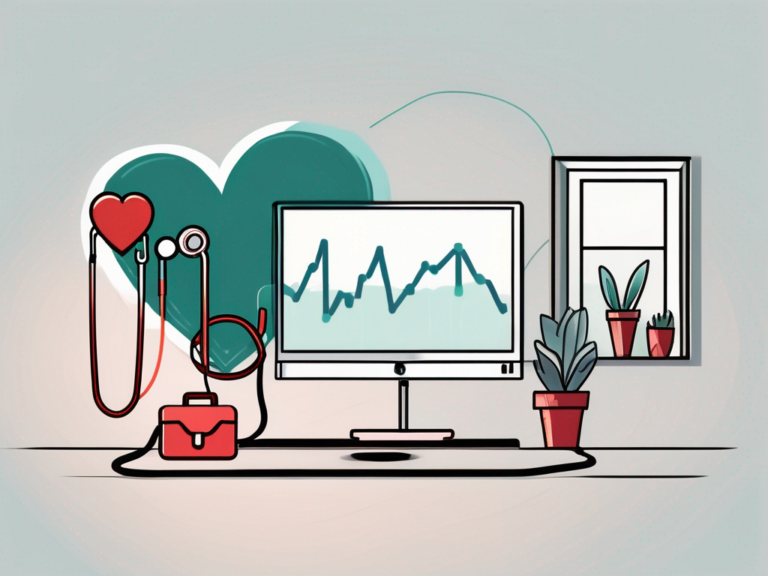How to Check Your Heart Health at Home
Your heart is a precious organ that plays a vital role in your overall well-being. Taking care of your heart health is crucial for a long and healthy life. While regular check-ups with healthcare professionals are essential, there are also steps you can take to monitor your heart health at home. By understanding the importance of heart health and having the necessary tools, you can keep track of your heart’s well-being and make informed decisions for a heart-healthy lifestyle.
Understanding the Importance of Heart Health
The heart is a remarkable organ that pumps blood throughout your body, supplying oxygen and nutrients to all your cells. It works tirelessly day and night to keep you alive and functioning optimally. Maintaining heart health is crucial because a healthy heart means a healthy body. By keeping your heart in tip-top shape, you reduce the risk of cardiovascular diseases and improve your overall well-being.
The Role of the Heart in Your Body
Every beat of your heart is life-giving. It pumps oxygen-rich blood to your vital organs, muscles, and tissues, ensuring they receive the nutrients they need for proper functioning. Additionally, it removes waste products and carbon dioxide, keeping your body running smoothly. Understanding the critical role your heart plays in your body motivates you to take the necessary steps to care for it properly.
Common Heart Diseases and Their Symptoms
Heart diseases can present themselves in different ways and have varying symptoms. By being aware of common heart diseases and their symptoms, you can recognize warning signs early and seek medical help promptly. Some common heart diseases include coronary artery disease, heart failure, arrhythmia, and heart valve problems. Symptoms may include chest pain or discomfort, shortness of breath, fatigue, dizziness, and irregular heartbeats.
Coronary artery disease is one of the most prevalent heart diseases, characterized by the narrowing or blockage of the coronary arteries that supply blood to the heart muscle. This condition can lead to chest pain, known as angina, or even a heart attack if the blood flow to the heart is completely blocked. It is essential to be aware of the risk factors for coronary artery disease, such as high blood pressure, high cholesterol levels, smoking, obesity, and a sedentary lifestyle.
Heart failure, on the other hand, occurs when the heart is unable to pump enough blood to meet the body’s needs. This can result from various factors, including weakened heart muscles, heart valve problems, or previous heart attacks. The symptoms of heart failure can be debilitating, causing fatigue, shortness of breath, fluid retention, and difficulty performing everyday activities. Early detection and management of heart failure are crucial to improve quality of life and prevent further complications.
Basic Tools for Monitoring Heart Health at Home
Equipping yourself with the right tools is essential for monitoring your heart health at home. Here are some basic tools you may consider:
Blood Pressure Monitors
Monitoring your blood pressure regularly is a fundamental aspect of heart health. By using a reliable blood pressure monitor, you can keep track of your blood pressure readings and detect any irregularities. This is especially important for individuals with hypertension or other cardiovascular conditions. Consult with your healthcare professional to ensure you choose a monitor that suits your needs.
When using a blood pressure monitor, it’s crucial to follow the proper technique. Sit in a comfortable position with your feet flat on the floor and your arm supported at heart level. Apply the cuff snugly around your upper arm and remain still during the measurement. Record your readings accurately, noting the date and time. Over time, this data will help you and your healthcare provider identify any patterns or trends in your blood pressure levels.
Heart Rate Monitors
A heart rate monitor allows you to track your heart’s beats per minute accurately. Whether you opt for a wearable device or a smartphone app, a heart rate monitor helps you monitor your heart rate during physical activities and at rest. Regularly checking your heart rate provides valuable insights into your heart health.
During exercise, your heart rate increases to meet the demands of your body. By monitoring your heart rate, you can ensure you are exercising within your target heart rate zone, which is typically 50-85% of your maximum heart rate. This zone is optimal for improving cardiovascular fitness and maximizing the benefits of your workout. Additionally, monitoring your heart rate at rest can help detect any abnormalities or irregularities that may require medical attention.
Smart Devices and Apps for Heart Health
Technology has made it easier than ever to monitor your heart health. Smart devices and apps can provide in-depth data analysis, track your physical activity, and offer personalized insights. These tools can help you stay motivated and provide a comprehensive overview of your heart health.
Some smart devices and apps even have features like sleep tracking and stress management, which are crucial factors that impact heart health. By monitoring your sleep patterns and stress levels, you can identify potential triggers and make lifestyle adjustments to improve your overall well-being. These tools can also help you set goals, track your progress, and celebrate your achievements, making the journey towards better heart health more engaging and rewarding.
Remember, while these tools are valuable for monitoring your heart health at home, they should not replace regular check-ups with your healthcare provider. It’s essential to work collaboratively with your doctor to develop a comprehensive plan for maintaining and improving your heart health.
Steps to Check Your Heart Health at Home
Now that you understand the importance of heart health and have the necessary tools, let’s explore some practical steps to check your heart health at home:
Regular Heart Rate Checks
Start by checking your resting heart rate. Find a quiet and comfortable place, sit still for a few minutes, and then measure your heart rate. A normal resting heart rate ranges between 60 and 100 beats per minute for adults. Monitoring your resting heart rate over time allows you to identify any variations and track changes in your heart health.
Blood Pressure Monitoring
Using a blood pressure monitor, regularly check your blood pressure at home. Aim for readings within the normal range, which is typically around 120/80 mmHg. Consistent tracking helps you identify any spikes or dips in your blood pressure, enabling you to address them promptly with the guidance of your healthcare professional.
Tracking Your Physical Activity
Engaging in regular physical activity is one of the most effective ways to maintain a healthy heart. Use a heart rate monitor or smart device to track your physical activity and monitor your heart rate during exercise. Aim for a target heart rate within your fitness level, and make adjustments to intensity as needed. Regular exercise keeps your heart strong and reduces the risk of heart diseases.
Additionally, it is important to incorporate a variety of exercises into your routine to challenge different muscle groups and improve overall cardiovascular fitness. Consider activities such as brisk walking, jogging, cycling, swimming, or dancing. These exercises not only elevate your heart rate but also strengthen your heart and improve blood circulation.
Furthermore, it is crucial to pay attention to your diet and make heart-healthy choices. Incorporate a balanced mix of fruits, vegetables, whole grains, lean proteins, and healthy fats into your meals. Limit your intake of processed foods, sugary drinks, and foods high in saturated and trans fats. Maintaining a nutritious diet helps reduce the risk of heart diseases and supports overall heart health.
Interpreting Your Heart Health Data
Collecting data about your heart health is only valuable if you can understand and interpret it correctly. Here are some key points to consider:
What is a Normal Heart Rate?
As mentioned earlier, a normal resting heart rate for adults ranges between 60 and 100 beats per minute. However, it is essential to consult with your healthcare professional to determine your target heart rate during physical activity, as it varies based on factors such as age, fitness level, and overall health.
Understanding Blood Pressure Readings
Blood pressure readings consist of two numbers – systolic and diastolic. Systolic pressure represents the force when your heart contracts, while diastolic pressure reflects the pressure when your heart relaxes between beats. Normal blood pressure readings are typically around 120/80 mmHg. However, ideal values may vary based on individual factors, so it is crucial to discuss your readings with your healthcare professional.
When to Seek Medical Advice
While home monitoring is valuable, it is not a substitute for professional care. It is essential to reach out to your healthcare professional if you notice any significant changes in your heart health data or experience concerning symptoms. They can provide expert guidance and determine the appropriate course of action based on your individual circumstances.
Now that you have a better understanding of heart rate and blood pressure, let’s delve into the importance of tracking other vital signs. Monitoring your heart health goes beyond heart rate and blood pressure alone. Additional vital signs, such as oxygen saturation levels and body temperature, can provide valuable insights into your overall well-being.
Oxygen saturation levels indicate how well your body is delivering oxygen to your organs and tissues. A healthy oxygen saturation level is typically above 95%. If you notice a significant drop in your oxygen saturation levels, it may indicate a potential respiratory or circulatory issue, and it is advisable to consult with your healthcare professional.
Body temperature is another vital sign that can provide valuable information about your heart health. While a normal body temperature is generally considered to be around 98.6°F (37°C), it can vary slightly from person to person. If you consistently experience high or low body temperatures, it may be worth discussing with your healthcare professional, as it could be a sign of an underlying health condition.
Maintaining a Heart-Healthy Lifestyle
Monitoring your heart health at home is just one part of maintaining a heart-healthy lifestyle. Here are some additional aspects to consider:
Diet and Heart Health
A heart-healthy diet plays a crucial role in maintaining optimal heart health. Incorporate nutrient-rich foods like fruits, vegetables, whole grains, lean proteins, and healthy fats into your meals. Did you know that colorful fruits and vegetables are packed with antioxidants that help protect your heart from damage caused by harmful free radicals? It’s true! So, make sure to fill your plate with a variety of vibrant produce.
Minimize the intake of processed foods, sugary beverages, and excessive salt. These foods can contribute to high blood pressure, high cholesterol levels, and weight gain, all of which can increase your risk of heart disease. Instead, opt for homemade meals that are low in sodium and added sugars. And if you need help creating a heart-healthy meal plan, don’t hesitate to consult with a nutritionist or healthcare professional for personalized dietary guidance.
Exercise for a Healthy Heart
Regular physical activity is essential for a healthy heart. Engage in activities you enjoy, such as walking, jogging, swimming, or cycling. Did you know that exercise not only strengthens your heart muscle but also helps lower blood pressure, improve cholesterol levels, and maintain a healthy weight? It’s like a triple win for your heart!
Aim for at least 150 minutes of moderate-intensity aerobic exercise or 75 minutes of vigorous exercise per week. And don’t worry if you can’t dedicate long chunks of time to exercise. You can break it down into shorter sessions throughout the day. Remember to warm up and cool down properly and listen to your body’s signals. If you experience any chest pain, dizziness, or shortness of breath during exercise, stop and seek medical attention.
Stress Management and Heart Health
Chronic stress can negatively impact your heart health. Implement stress management techniques such as meditation, deep breathing exercises, yoga, or engaging in hobbies you enjoy. Stress can elevate your blood pressure, increase inflammation in your body, and lead to unhealthy coping mechanisms like emotional eating or excessive alcohol consumption.
Prioritize self-care and make time for activities that help you relax and unwind. Whether it’s taking a bubble bath, reading a book, or spending quality time with loved ones, find what works best for you. Taking care of your mental well-being is an essential component of a heart-healthy lifestyle. Remember, a happy heart starts with a happy mind!
Monitoring your heart health at home empowers you to take an active role in your well-being. By understanding the importance of heart health, using the right tools, following appropriate steps, and maintaining a heart-healthy lifestyle, you can strive towards optimal heart health. Remember, always consult with your healthcare professional for individualized advice and guidance. Let your heart be a constant reminder of the love and care you deserve!






